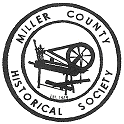|
Monday, October 31, 2011
Progress Notes
The last month I have been dealing with the pain of a couple of molars requiring root canal for one and an extraction for the other. Although such things aren’t pleasant I did marvel about how the profession of dentistry has progressed over my lifetime. We now have several types of subspecialties in the field of dentistry. Already, I have seen a general dentist, an endodontist, and a periodontist. Such things as “bridges” and “implants” are being discussed.
When I was very young I remember being taken to Kansas City to have a number of primary teeth removed because of multiple cavities; apparently, I had not been cooperative enough to have the cavities drilled and filled. I remember the first dentist I saw locally was Dr. Almquist of Eldon (he later moved to Sedalia). In those days dentistry certainly had become more advanced after local or general anesthetic became available, and cavities could be drilled out with the electric motor powered mechanical drill. I don’t remember x rays being taken then.
These days x rays are taken and immediately converted digitally to a JPG format which can be printed or stored in a computer.
At any rate it occurred to me that our website had not devoted any space to the history of the dental profession in Miller County. One reason is that no history source I have consulted says much about it. Even Peggy Hake wrote me the following after I asked her if she had written about Miller County dentists:
“No, Joe, that is one subject I have never researched or written about. As a child I can't remember dentists who were around but I am sure there were a few! Dr. Dawson, at Eldon, was the one I can recall in later years.....I'm going to the Genealogy Center here in Independence today and I will see if I can find any reference to this subject.”
|
And here is what Peggy found:
“Joe, I have just returned from the Genealogy Center and looked in the Miller County history books written by Goodspeed, Schultz, and Jenkins. The only reference I could find to a dentist was one who was named Dr. R. T. Harrison who was practicing medicine and dentistry at Iberia around 1898-90. I looked in the 1880 census of Miller County but couldn't find anyone named R.T. Harrison, so at this time I have no idea who he was......”
|
It seems that early on in the history of our county, dentists were itinerants who might travel a regular circuit to care for those who had dental needs; and even if they lived here, they seemed to move on after awhile. After a good deal of research I have found the names of a few dentists of the late 19th century who practiced here for awhile.
One of the early ones was mentioned in a short sentence of a Tuscumbia published newspaper, the Vindicator:
Miller County Vindicator 21 June 1881, Vol.3 #88
"Dr. B. E. Boone, dentist, called on us Thursday morning."
Here is what Peggy wrote about that short sentence:
“I have tried to find the identity of Dr. Boone but found nothing. He may have been a traveling dentist who went from town to town offering his services for a short while then would move on.”
|
One of the earlier dentists who lived in Miller County was Dr. J.A. Taylor. The Eldon Advertiser in 1909 wrote a short narrative about him:
Eldon Advertiser
June 10, 1909
Dr. J.A. Taylor
Dr. J. A. Taylor of Eldon is a pioneer dentist and one of the well known men of his profession in this section of the country.
Dr. Taylor has followed his profession for a period of thirteen years and is best know for his bridge work where he tips the teeth having been mentioned at length in some of the leading dental journals of the country. Dr. Taylor gave a clinic demonstrating the efficiency of his method before the Western Alumni Association in Kansas City, at Nold's Dental Exhibit in St. Louis, lasting a week and also before the State Dental Association in St. Louis.
Dr. Taylor's tipping method has earned for him a degree of distinction of a gratifying nature. He enjoys a large practice in Eldon where he is known as a man fully in command of the best ethics of the profession.
Here are some photos of Dr. Taylor and his wife, family, and home sent me by Mike Weineman (photos 01a - 01d):
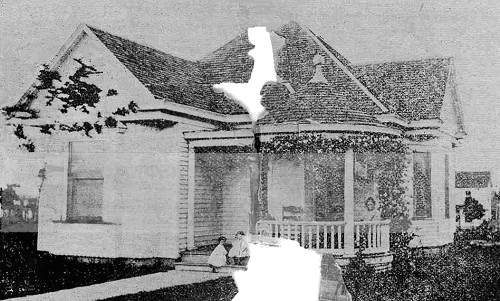
01a Dr. J.N. Taylor Home
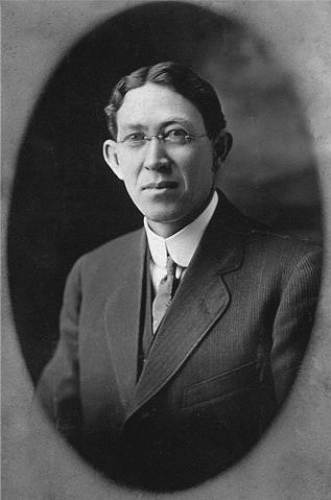
01b Dr. Joseph Alexander Taylor, Dentist in Eldon
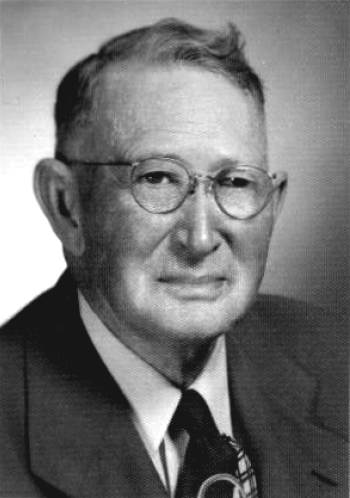
01c Dr. J.A. Taylor
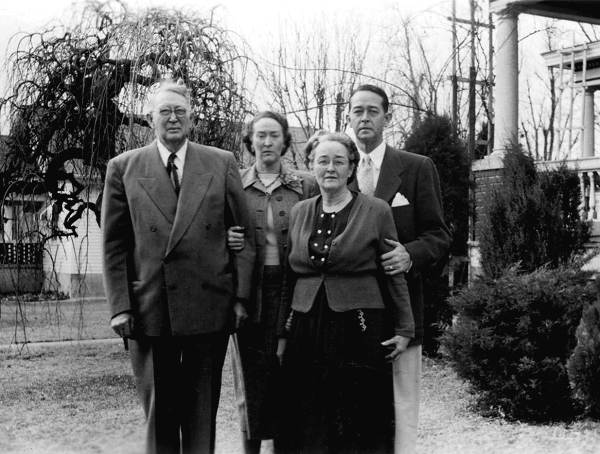
01d Dr. Joseph and Myrtle Taylor, Ruth and Gail Taylor
In the 1940’s Irene Fitzgerald, well known Miller County teacher wrote a history of Miller County in which she mentioned the names of some early Eldon dentists:
“Dr. J.A. Taylor, Eldon’s first dentist started before 1900. Following him were Dr. F. Enloe, 19**, Dr. L. Layne 1918, and Dr. W. H. Brockman, 1919. Four dentists are in active practice here now…Dr. Almquist, Dawson, Frutiger and Brockman.”
We have Irene’s history on our website at this previous Progress Notes.
Search of our website finds a few more dentists who practiced for a while in Miller County:
Dr. E.D. Suggett:
“In the 1939 fire that destroyed much of downtown Iberia, one of the buildings destroyed was called the Clarence Casey building, formerly the office of Dr. von Gremp and was occupied at the time of the fire by Dr. E.D. Suggett, a dentist. The Adams and Casey Mercantile building was a complete loss including the funeral home on the second floor, located on the northeast corner of St. Louis and Main Streets. Their loss in merchandise and funeral supplies was about $16,000. Most business places were not covered with insurance because of the exorbitant prices even in those days with the buildings built close together and made of wood.”
Guy Smith:
“For most of its existence, Bray's Mill has supported and survived as a grist mill. However, it has also served as a Post Office, a safe haven for tired travelers, a dentist office (operated by Guy Smith)…”
Dr. R.T. Harrison:
“In 1880 the face of Iberia had change somewhat. The town had been officially incorporated as a village on Aug. 3, 1875 and by 887, many businesses had been established including: Marquis W. Fancher, merchant; John L. Arnold, lawyer; Thomas D. Garner, merchant; Rev. J.S. Harris, Methodist minister; Rev. W. W. Hicks, Congregational minister; Joseph Hume, wagon maker; Joe Jacob and Thompson, merchants; F.E. Lombar, merchant and postmaster; George Johnson, James. M. Rowden, and J.C. Thompson, blacksmiths; John H. Moore physician and druggist; J.W. Wade, physician; T.D. Garner and Son Roller Mills; E. Hendericks, proprietor of the Iberia Hotel; John Kellison, saddlery and harness; Miles J. Davidson, merchant; Dr. R.T. Harrison, dentist; Robert A. Harper, jeweler; Henry R. Hoover, boot and saddlemaker; and Sarah J. Hughes, keeper of a boarding house.”
These are the only names I could find of dentists who established offices in our county in the early years. A number of Miller County natives who were raised here can be found who went to dental school but practiced elsewhere. I have not researched those.
One dentist who was raised in Miller County started his practice in Eldon soon after WWII. His name is Jack Dawson. Here is a photo of Jack and his family probably taken in the 1950’s (photo 02).
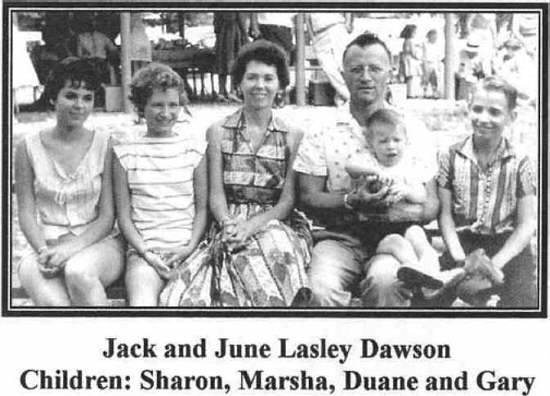
02 Dr. Jack Dawson and Family
I previously wrote for our website Jack’s biography.
Of course, after WWII a number of dentists came to practice in Miller County but I haven’t made a search for their names. And I could have missed the names of other dentists who practiced here earlier in the last century before WWII but these are all I could find.
Growing up I heard many stories about how awful it was to have to go to one of the old time dentists since the tools of the trade were primitive and especially since no anesthetic modalities were available except for whiskey. I found an article on the internet which describes in detail the state of the art of dentistry in the mid to late 18th century:
Medicine in the Old West: A History, 1850-1900
Jeremy Agnew
In those days, if a person suffered from a sudden toothache, his jaw swelled up, and by evening he was in severe pain. No one had surgical instruments so he tried to pull out the offending tooth with an old pair of hand operated bullet molds.
The jaws of the mold kept slipping off the tooth, so finally, not knowing what else to do, his partner knocked out the tooth with a spike and hammer. If a tooth was not too far gone with decay and could still be saved dentists drilled out the cavity and inserted a filling made from gold foil, held in place by a creosote material. If a patient did not want a filling material as expensive as gold, tin foil also could be used for fillings. A tooth that was merely broken might have the rough edges removed with a metal file or even a piece of sand paper.
A small town in the middle of nowhere, or a remote mining camp, did not have a regular dentist, but might be visited occasionally by a traveling dentist who journeyed around a regular circuit of small towns and outlying areas. These itinerant dentists set up a temporary office in a local hotel or in the back of a saloon and extracted teeth that had gone bad since the last visit.
Traveling dentists might have a kitchen chair with a home made headrest, or even just a folding chair. A kerosene lamp was used for light and whiskey served double duty for sterilization and as an anesthetic.
Even though soldiers at frontier posts during the Indian Wars had some of the best surgeons and medical care, they did not have dentists or routine dental care. The Military Dental Corps was not formed until 1901. As with other tooth sufferers on the frontier, treatments for tooth problems for soldiers was generally limited to the post surgeon who pulled a decayed tooth when it caused enough pain.
People on the frontier in those early days used a visit to the dentist as an excuse to drink large amounts of whiskey. They drank before the extraction to dull the inevitable pain, and afterwards to dull the residual ache afterward.
Part of the problem of dentistry on the frontier was that people couldn’t always tell which specific tooth was causing the pain. Because practitioners had to rely on the patient to tell them which tooth was causing problems, it was not unusual for the dentist to pull the wrong one. A dentist had to be a fast talker to explain this error.
The basic dental implement was a good pair of plier like forceps for which to yank out aching teeth.
Another important instrument was a toothkey, a T shaped device that hooked around a tooth and was then pulled upward to extract the entire tooth.
At least, that was the theory. The result of this violent maneuver was that often a rotten tooth broke off at the gum line, and the remaining pieces had to be gouged out of the socket with a dental elevator, a device that looked like a small chisel.
The use of a toothkey also sometimes broke the patient’s jaw, which left him or her in more pain than before.
Various specialized designs of dental instruments included forceps intended for extracting specific teeth. Other specialized forceps with curved gripping surfaces, were used for extracting fragments of teeth left by the tooth key, and for stumps of teeth that had rotted beyond the ability of simple removal. Scaling instruments for removing a build up of tartar and other debris were available.
Dental instruments were treated with as much care as other contemporary surgical instruments and might be piled in a heap by the dental chair without being washed or sterilized between patients. The first dental tools were made with wooden handles…simply because handles on all sorts of tools had traditionally been made from wood. When the practice of sterilization of dental instruments became commonplace, instrument manufacturers realized that wooden handles would not withstand the process, and dental tools were constructed completely from metal.
Early dental drills were hand tools that gouged out tooth decay more than drilled it out.
The dental drill turned by a flexible cable was introduced by Charles Merry of St. Louis in 1858.
This device was powered by the dentist’s foot pumping up and down on a pedal that operated a pulley to drive a belt to turn the drill bit. The bit rotated relatively slowly, making progress of the drilling very tedious and transmitting low vibrations through the patient’s jaw to the rest of his head, creating a dull, grinding sound. This was accompanied by the smell of burning tooth enamel due to heat created by the slow cutting action of the drill bit. The lack of local anesthetics to dull the nerve in the tooth being drilled made the whole procedure very painful. Today’s dental drills operate at high speed, cutting fast without the accompanying dull, throbbing vibrations in the skull.
Dental patients did indeed have something to worry about when they went to visit the dentist. Before anesthetics were introduced, the dentist often physically held his patient down in the chair with a knee on the chest while he yanked, pried, and twisted a bad tooth out of its socket as best he could.
This was not always an easy task for a dentist to perform while his patient squirmed beneath him and groaned through the mouthful of instruments. The introduction of ether and nitrous oxide anesthetics in dentistry in the early 1840’s eliminated these crude procedures making the process easier for both patient and dentist. One alternative before gas anesthesia was developed, was to put opium or cocaine into the cavity of the decayed tooth in order to dull the nerve before extraction.
Several drugs could be applied to an aching tooth to temporarily ease the pain. One was cajuput oil, which was made from the leaves of the melaleuca leucadendron tree from Indonesia.
A few drops, mixed with sugar were also used to relieve spasms of the stomach and bowels. Ginger and mustard, made into poultices and applied to the cheek, were employed to relieve the pain of a toothache. What must have been the ultimate remedy for toothache was a mixture of sassafras oil, oil of cloves, summer-savory oil, and oil of cedar. The combination was applied to the tooth with a piece of lint. This must have been a powerful combination indeed, because all of the ingredients could be used separately to achieve the same purpose.
After decayed teeth were pulled out, replacement teeth were important both for cosmetic reasons and to restore lost function. A set of false teeth cost about eight dollars. Early tooth replacements were made from carved bone, ivory, or even natural animal or human teeth. Sometimes false teeth were made from hippopotamus or elephant tusks, which were a form of modified animal teeth.
For dentures to fit correctly, all of the old teeth had to be pulled, which was a horrible procedure to contemplate. Patients consumed copious amounts of whiskey, wine or laudanum to dull the pain and the subsequent ache in the jaw, but it was still a very painful process.
Before proper techniques for installing dentures were developed, teeth were glued to the remaining roots of the patient’s own teeth. It later developed that this procedure was not particularly successful. The remaining root of the tooth continued to decay in the jaw, and the glue used to hold the false teeth in place discolored or turned black. With continued improvement of techniques, dentists learned how to extract the entire tooth in order to prevent further decay.
The development of vulcanization of natural rubber by Charles Goodyear in 1839 led to the use of vulcanite (hard rubber) for dentures.
Dentists, noting the use of celluloid (a plastic based on cellulose nitrate) for billiard balls by J. Smith Hyatt in 1869, quickly adapted the same material for dentures.
The second half of the nineteenth century saw the development of improved false teeth that were made from porcelain, which was a mixture of the minerals feldspar, quartz, and clay. These ingredients were baked at high temperature to form a hard, impervious material that was ideal for dentures.
In the late 1800’s before electricity was available a dentist office would have a special chair and a foot operated drill.
I found interesting the fact that Dr. Taylor of Eldon mentioned above was one of the first dentists to place bridges across the area of a tooth which had been removed. That would have been way back in the early 1900’s. However, nowadays, often instead of a bridge a titanium implant is placed in the bone and a manufactured tooth is attached to it. That spares the teeth on either side from having to be modified to accommodate a bridge. Most periodontists do this procedure in three stages over about six months time. However, my cousin Max Pryor, who has had three of these procedures, sent me a video on YouTube of a periodontist who does the whole process at one visit. You can even see it done before your very eyes at this YouTube website:
Which leads me to the next topic of local current interest in bridges of a different kind regarding the replacement of the old Buechter swinging bridge near St. Anthony on Buechter Road. Here is a recent photo from the Autogram regarding the story (photo 21):
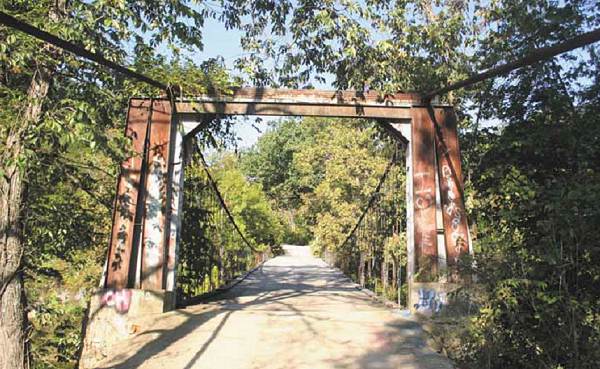
21 Steel for the Buechter Bridge replacement project has arrived more quickly than originally planned
and the suspension, or swinging, bridge near St. Anthony on Buechter Road will be closed
Monday, Oct. 24. The crossing will remain closed until the new bridge is complete, the Miller County
Commission has announced. Originally, construction was scheduled to begin in November.
The bridge will be replaced with a concrete span bridge. Lehman Construction is in charge of the project.
(Photo by Heather Finch-Leuthen)
I called Tom Wright, Presiding Commissioner, who told me that we now have only three swinging bridges still in use in the county: Kemna, Mill Creek, and Auglaize Creek bridges. At one time we had eight swinging bridges in the county, all built by Joseph Dice. They were:
1. Tuscumbia Swinging Bridge Dice 1905 (photo 22)
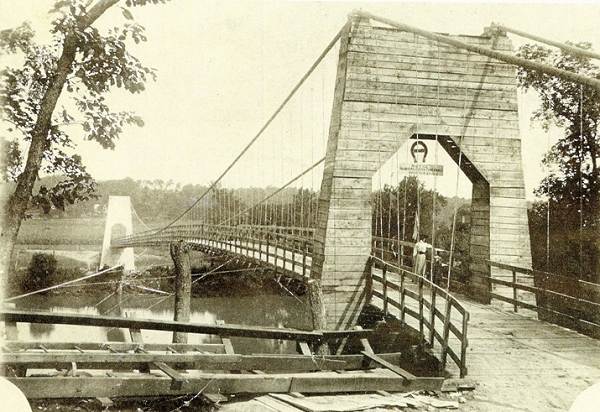
22 Swinging Bridge at Tuscumbia: 1905-1934
2. Buechter Bridge Dice 1920 (photo 23)
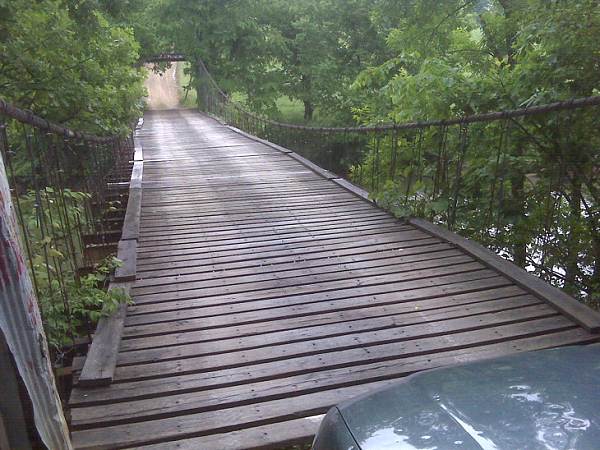
23 Buechter Bridge
3. Kliethermes Bridge Dice 1920 (photo 24)
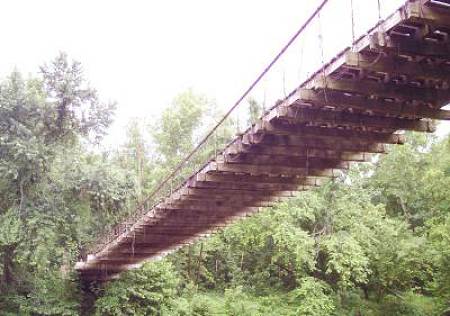
24 Kliethermes Bridge - Dice
4. Kemna Bridge Dice 1924 (photo 25)
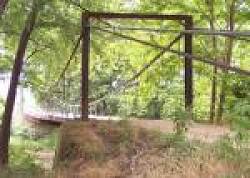
25 Kemna Bridge - Dice
5. Boeckmann Bridge Dice 1926 (photo 26)
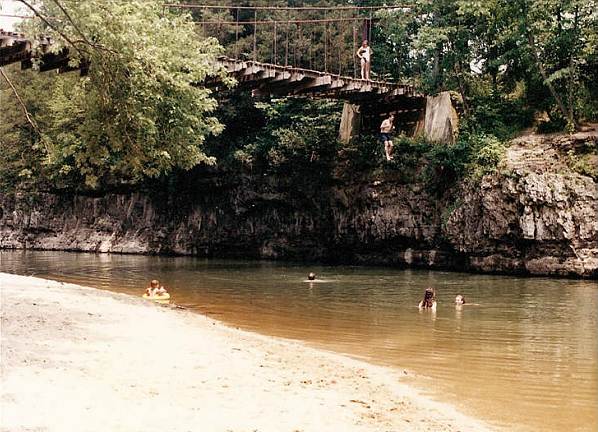
26 Boeckman Bridge - Dice
6. Auglaize Bridge Dice 1931 (photo 27)
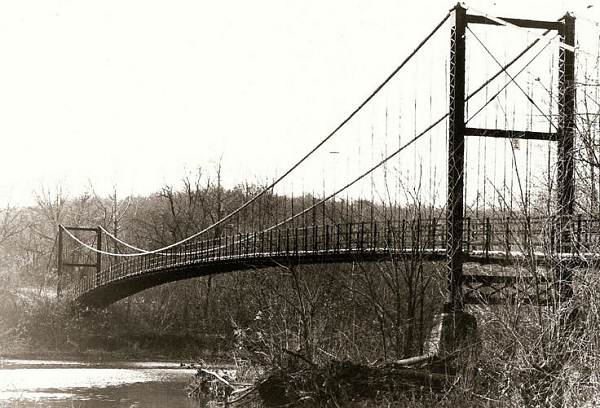
27 Auglaize Bridge - Dice
7. Mill Creek Bridge Dice 1931 (photo 28)
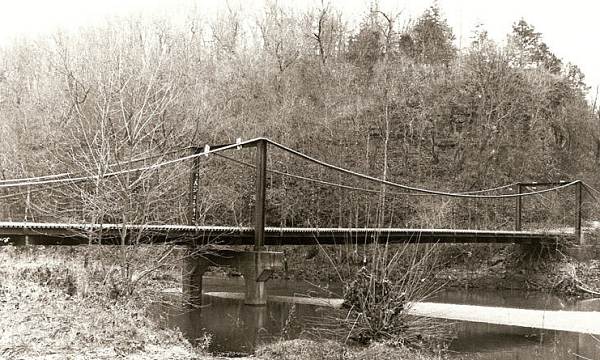
28 Mill Creek Bridge - Dice
8. Brumley Bridge Dice (near St. Anthony, year of construction not confirmed) (no photo)
Joseph Dice must be one of the most interesting persons who had some part in the history of our county. Although he was from the Warsaw area, he probably built more bridges here than any other county. Peggy Hake has written his history which is found on our website in the section which discusses Miller County bridges:
JOSEPH DICE, BRIDGE BUILDER (1866-1947)
By Peggy Smith Hake
Joseph/Joe Dice of Warsaw, MO, began his bridge-building career as a young apprentice to Dr. D. M. Eddy in 1895 on the Stockton Bridge. His later success led to his constructing as many as 40 swinging bridges in central Missouri, including some in Miller, Maries, Benton, and Cooper Counties.
All his bridges were 14 ft. wide as today's traffic could not be imagined at the time he first built these bridges. Starting with a ball of twine to judge the curve and distance, men in boats or horses to pull the wires across, men and mules to mix cement and haul river gravel and timbers from local farms, his genius has long gone unrecognized.....We are told Mr. Dice could tell by the 'feel' of the wire if the tension was right. As many as 950 strands of wire were required to carry the weight of the cables. When the highway department required blueprints for construction, Mr. Dice retired as a bridge builder!!
In Miller County the bridges he built were:
- Auglaise and Mill Creek bridges near Brumley
- Kliethermes/Brumley Bridge and Buechter bridges near St. Anthony
- Boeckman and Kemna bridges near St. Elizabeth.
The two bridges he did not construct in Miller County were the Singer Bridge and the Hoecker Bridge, both located in Osage township near St. Elizabeth.
In Maries County he constructed an old bridge about 2 miles from Vienna. It is 180 ft. wide and is used for pedestrian traffic only.
In Benton County he constructed the old bridge at Warsaw which spans the Osage River. It is 500 ft. long and is used only for pedestrian traffic. The new Highway 7 Bridge is located nearby.
In Cooper County he built Klenklen Bridge, located about 11 miles southwest of Pilot Grove.
Kliethermes Bridge is still standing but not accessible to traffic. It is in a poor shape and not safe to cross. The county court/commission closed it off a couple of years ago. It is very unique but very dangerous. There is not much traffic on these country roads where the bridges are located. Most of them span the Big Tavern creek which meanders across Miller County. The bridges that are still in use include Buechter Bridge (south of St. Anthony), Kemna Bridge (southeast of St. Elizabeth), Mill Creek Bridge and Auglaize Bridge (near Brumley in Glaize Township).
The bridges that are no longer used include Boeckman (replaced with new bridge), Singer Bridge, and Hoecker Bridge (replaced with a new bridge).
Peggy Hake
Peggy didn’t mention the Tuscumbia Swinging Bridge but it also was built by Joseph Dice. You can read more about it at this previous Progress Notes.
Unfortunately, I was unable to find a photo of Joseph Dice even after much research.
The most well known of the Miller County Swinging bridges are the Mill Creek and Auglaize bridges. Quite a few articles have been written about the two bridges, maybe because they are located close to the Lake of the Ozarks State Park where many tourists visit. A few years ago Rae Vae Edwards wrote a short article for the Jefferson City Tribune about these two bridges which are still standing. However, since she wrote the article a few more of the other swinging bridges in the county she mentions no longer are standing but have been replaced:
Just a swingin'
Old bridges remain interesting landmark
By Ra'Vae Edwards
Jefferson City News and Tribune (date not listed on this copy)
(see photo 28 above)
BRUMLEY, Mo. - At one time, according to area history, there were eight swinging bridges in Miller County. Today, there are only six remaining and two of them can be found very near the small community of Brumley.
Once popular hangouts in the summer, the two bridges are more than 75 years old and are in need of repair, but still an interesting landmark.
About two miles from Brumley, on a gravel road now called Swinging Bridges Road (Lake Road 42-18) is the Auglaize Bridge and the Mill Creek Bridge.
The Auglaize Bridge is the largest of the swinging bridges in Miller County.It was built in 1931 after the construction of the Bagnell Dam caused the waters of the Auglaize Creek to back up. It is 400 feet long.
The Mill Creek Bridge, just a short distance away, spans a small waterway known to locals as Mill Creek. It is only 100 feet long, considerably smaller than its neighboring bridge.
The two bridges are more commonly referred to by local residents as the Twin Bridges.
Although both bridges are in dire need of repair, the thought of rebuilding either of them brings sadness to the people who grew up in the area.
"My dad helped to build those bridges," said lifetime Brumley resident Lloyd Degraffenreid. "I was born in 1927 so I wasn't very old when those bridges were built. They used to be a real popular hangout for families in the summertime. People would go down there and have picnics, go swimming and camp-out."
The Twin Bridges were designed and built by Joseph Dice, who constructed as many 40 swinging bridges throughout several Mid-Missouri counties, including Miller, Benton, Maries and Cooper.
There is a Missouri State Park located next to the Auglaize Bridge, which is open to the public.
If you plan to visit the swinging bridges, be sure to roll the windows down to get the "full effect." It will sound like you are crossing an old wood-frame roller coaster.
The bridges are sturdy and will hold, but are open to local traffic only.
Both the Auglaize Bridge and the Mill Creek Bridge are listed as historic bridges with the Historic Bridges of the United States organization.
Mill Creek Bridge, one of the few swinging bridges left in Missouri, is still a popular attraction in the Brumley area. The Auglaize Bridge is located just a short distance down the road from this bridge.
Well, that completes the stories of the Miller County swinging bridges and dental bridges as well.
That’s all for this week.
 Joe Pryor
Previous article links are in a dropdown menu at the top of all of the pages.
|

